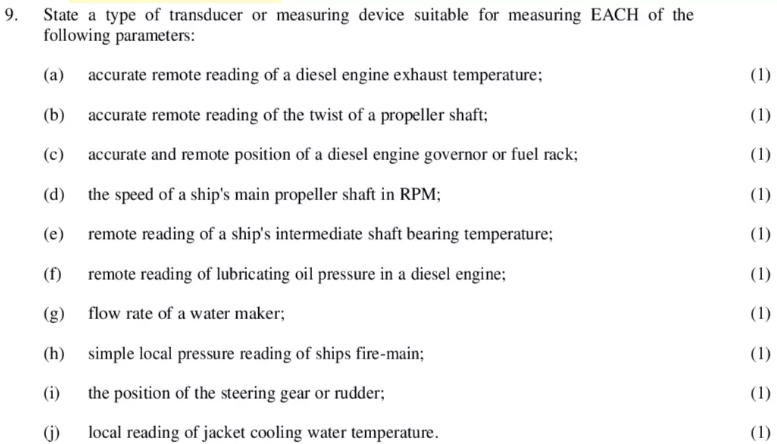Study Notes Quiz

With reference to a PT100 probe (resistance thermometer):
(a) explain the principle of operation by which it is able to give a temperature measurement;(3)
(b) describe how the sensing element is constructed, explaining why it is called a PT100 probe;(4)
(c) explain why these probes typically have three or four wires to connect them to the temperature indicating device.(3)

(a) Explain, with the aid of a sketch, the design and operation of a thermocouple.(8)
(b) State ONE limitation of the thermocouple, stating how this is overcome in practice.(2)

List FIVE different methods of remotely monitoring the content level of a fuel oil service tank, explaining their operating principle.
(10)

(a) Describe with the aid of a sketch, how Bi-metallic strips are utilised to measure temperature.(8)
(b) State a typical application for this type of device and its main shortcoming.(2)

(a) Describe, with the aid of a sketch, the principle and operation of a potentiometer.(6)
(b) Explain how a potentiometer can be used to measure rotary movement.(4)

With reference to a thermistor:
(a) state the materials used in their construction, the principle of operation and the reason for their use on vessels;(4)
(b) state the temperature range over which they are able to operate;(1)
(c) state, with reasons, FIVE applications where thermistors may be found on board a vessel.(5)

(a) Describe, with the aid of a sketch, how a Bourdon Tube can be utilised to measure temperature.(8)
(b) State a typical application and location for this type of device.(2)

Describe, with the aid of a sketch, a method of measuring and remotely indicating EACH of the following:
(a) temperature;(4)
(b) rate of flow.(6)

With reference to an impeller type flowmeter, describe how an output is produced and processed to provide EACH of the following:
(a) an analogue output in litres per minute;(5)
(b) a digital output in litres per minute.(5)

Describe, with the aid of a sketch, a floatation device that produces an output signal to remotely control the liquid level in a tank.
(10)

With reference to capacitance probe sensors:
(a) describe, with the aid of a sketch, how a capacitance probe produces an output which can be used to measure the liquid level in a tank.(7)
(b) state TWO different uses of this device on a vessel:(2)
(c) state ONE disadvantage of this type of probe.(1)

(a) Explain, with the aid of a sketch, how the fluid level in a tank can be measured using ultrasound energy.(6)
(b) State TWO advantages of using ultrasound.(2)
(c) State TWO limitations of this type of measuring device.(2)

With reference to strain gauges:
(a) describe, with the aid of a sketch, the principle and operation of a simple strain gauge, stating the formula used to determine its change in properties;(5)
(b) explain how the device is connected into an electrical circuit to accurately measure pressure;(3)
(c) state TWO practical applications in a vessel.(2)

State a type of transducer or measuring device suitable for measuring EACH of the following parameters:
(a) accurate remote reading of a diesel engine exhaust temperature;(1)
(b) accurate remote reading of the twist of a propeller shaft;(1)
(c) accurate and remote position of a diesel engine governor or fuel rack;(1)
(d) the speed of a ship’s main propeller shaft in RPM;(1)
(e) remote reading of a ship’s intermediate shaft bearing temperature;(1)
(f) remote reading of lubricating oil pressure in a diesel engine;(1)
(g) flow rate of a water maker;(1)
(h) simple local pressure reading of ships fire-main;(1)
(i) the position of the steering gear or rudder;(1)
(j) local reading of jacket cooling water temperature.(1)
